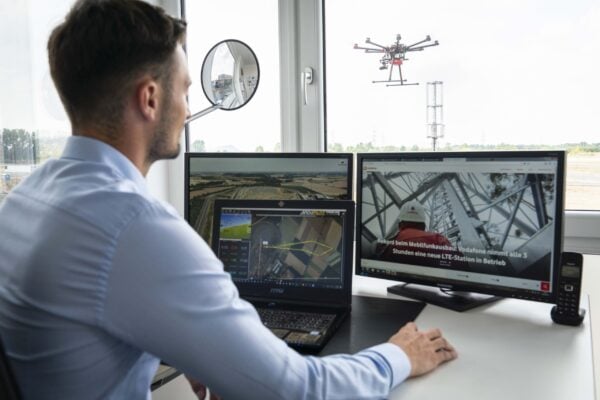
Vodafone and EASA look at airport protection from drones
As the drones take to the sky, the demands on legislation and safety systems also increase. The European Aviation Safety Agency (EASA) and Vodafone are working together on a digital protection system for European air traffic. In the Aldenhoven 5G Mobility Lab, the partners have for the first time in Europe tested the remote control of drones outside the field of vision via mobile radio. In an emergency, drones will also be able to be piloted away from security zones by authorized personnel.
At airports, drones are increasingly becoming a danger. Pilots are reporting more and more hobby drones over German airports. The small aircraft cannot be detected by conventional radar, so they go unnoticed by air traffic control. This year, for the first time, more than 100 of these small flying objects were located in the safety zone of airports, as reported by German air traffic control authorities.
In the 5G Mobility Lab, Vodafone demonstrated how mobile radio can make drone flights over long distances safer. This supports one of EASA’s central goals. A digital system is to ensure that drones can be located and monitored if they fly outside the owner’s range of vision and are not detected by radar. In the future, digital security zones will also be set up at sensitive locations such as schools, hospitals, prisons and airports.
The basis for this is the fact that mobile radio can locate threats that are invisible to conventional radar. Based on this knowledge, Vodafone has developed a radio positioning system (RPS) that makes it possible to locate drones. A SIM card fitted to the drones connects the flying objects to the Internet of Things. Artificial intelligence algorithms constantly and accurately calculate the geographical position of a drone. On the basis of these calculations, the system automatically determines whether a drone leaves an agreed flight path. Remote control of the drone from a safety center can protect aircraft, civilians and sensitive equipment from accidents.
For the joint tests, representatives of EASA and the European Commission travelled to Aldenhoven to the 5G Mobility Lab. In live operation, the partners demonstrated that drones can be located and remote-controlled by LTE at altitudes of up to 120 meters above ground. In the next steps, techniques will be tested to keep drones away from no-fly zones. “These tests are helpful in the development of a regulatory framework for drone flights. In this way, we are creating the conditions for important new economic potential in Europe,” says Yves Morier, responsible for flight safety standards at EASA.
A study commissioned by the European Union shows that a regulated drone service industry can contribute more than 15 billion euros to the European economy by 2050. This could create 100,000 additional jobs. European companies are considering the use of drones for a wide range of tasks. Small and high-value goods as well as medicines can reach the recipient faster than before with drones. In disaster areas, drones can support rescue forces and provide important live images under dangerous conditions, for example.
Related articles:
Drone fleet can search under dense forests without GPS
Airbus starts production of solar powered surveillance drone
EPFL Drone Days: a showcase of flying technology and robotics
 If you enjoyed this article, you will like the following ones: don't miss them by subscribing to :
eeNews on Google News
If you enjoyed this article, you will like the following ones: don't miss them by subscribing to :
eeNews on Google News



